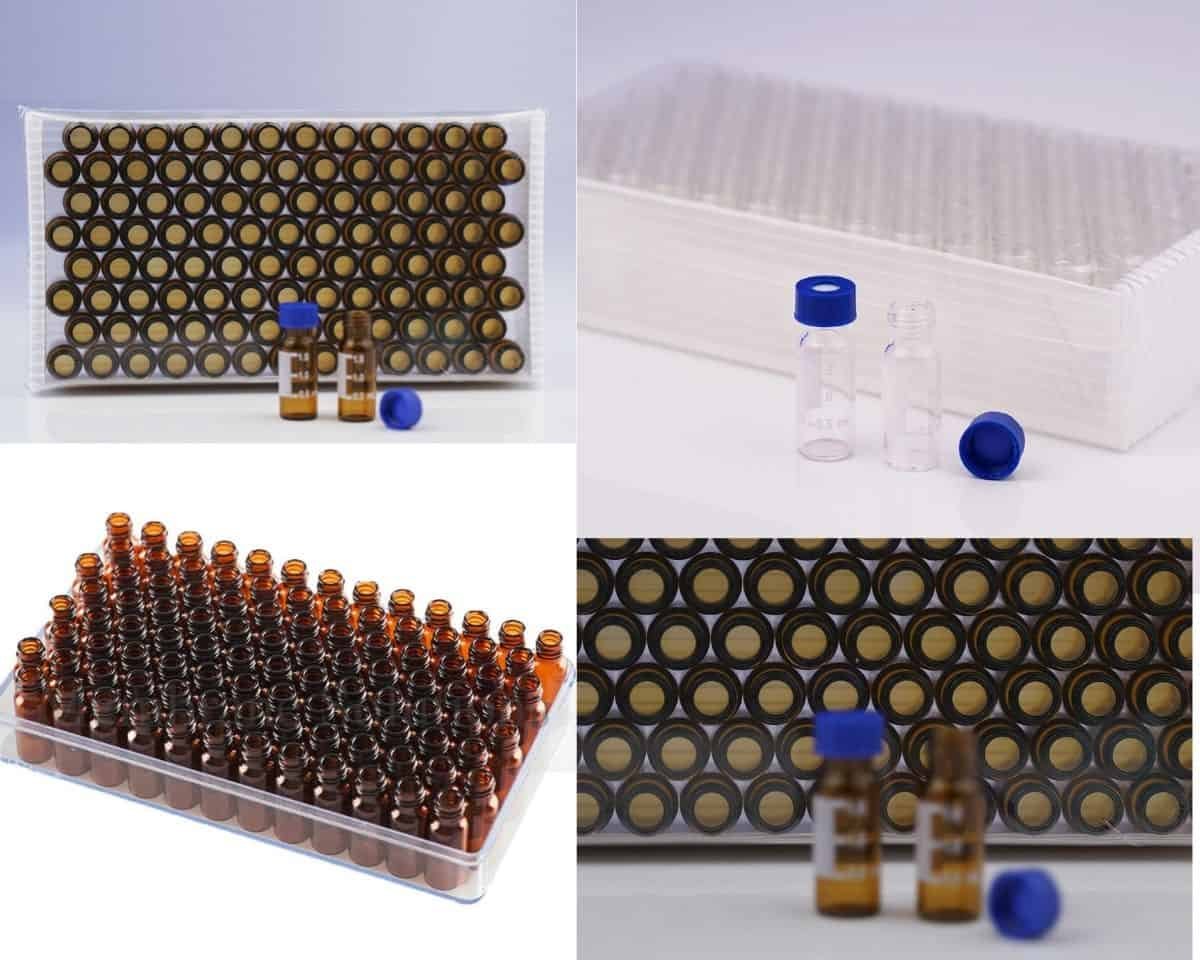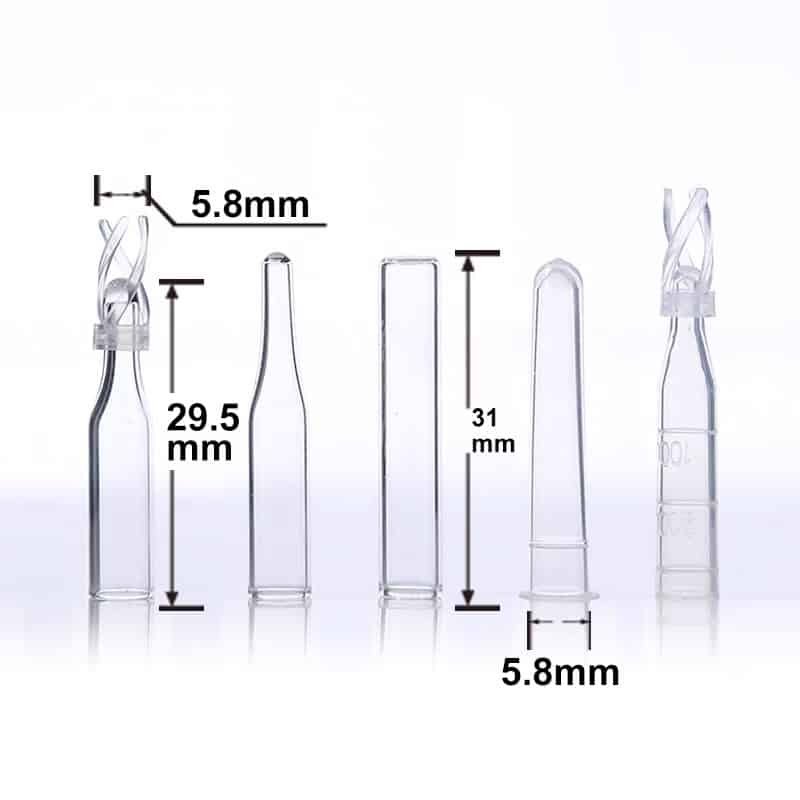

Choosing the right vial is essential to make the most out of our samples. With the wide variety of available vials, confusion is normal. It can happen even to the most experienced among us.
Since recovery vials are crucial for small sampling processing, we wanted to share our expertise with you. This will help you achieve the best results by choosing the right vials for every occasion.
Throughout this article you will learn more specifically on what is the difference between integrated and recovery vials for 2ml ND9 Neck Type, although there are many other types that are not addressed significantly in this article. We will also get into detail about their materials, uses, and answer your most frequently asked questions.
What Are Recovery Vials and Integrated Vials?
They both guarantee that you get the most out of your priceless sample. For sample recovery, a conical bottom design can decrease product waste by up to 99%.
When picking the proper vial, consider the amount of material available for analysis.
You’ll have to use an insert for your ordinary autosampler vial if you have a small number of samples. That would be a high-recovery vial or an integrated vial.
Note: Depending on where the manufacturer measures the vial full, most 12×32 mm autosampler vials carry from 1.5mL to 2.0mL of liquid.
Manufacturers all use the same parameters for 12x32mm vials. However, the vial shoulder’s neck length and width/shape may differ. Accordingly, Based on my experience, it may be best to buy a set from the same supplier or to ask for samples before buying in bulk. This is because a cap may not fit the vial, causing an issue.
12x32mm micro vials have the exact same outer dimensions. But, the inside of the vial may be tapered to reduce the volume or contain a fused insert. High-recovery vials of the same dimension allow for a better sample recovery since they have a conical bottom inside.
Now, what is the definition of the two vials?
Recovery vials are high-recovery vials that allow for:
1. Entire sample collection
2. Automated handling and storage
3. Maximal sample retrieval
An integrated vial is a vial that has inserts, and manufacturers can intend it to be a recovery vial.
What Glass Type Do We Have for the Recovery Vial?
USP is short for United States Pharmacopeia. It defined the test techniques and specification limitations.
There are a few types of glass we use in our research:
USP Type I
Borosilicate Glass is a highly chemically resistant glass. We commonly use it in pharmaceutical applications. We use it where we need sterilization or the absence of reactivity.
Soda USP Type II
Internally treated lime glass with sulfur compounds. Manufacturers do that to replicate the qualities of USP Type I glass.
Soda Lime glass, USP Type III
It has a moderate chemical resistance.
Type NP
General Purpose (USP) soda-lime glass, which we use when the following is not essential:
1. Chemical resistance,
2. Thermal shock resistance.
What’s the Difference Between an Integrated Vial and a Recovery Vial?
A recovery vial is a glass-integrated vial welded with a glass insert during the manufacturing process. Insert that manufacturers use is a conical insert, 250uL. The fixated insert allows convenient handling for the injection of a solution.
The tapering conical finish of the vial bottom allows the needle to draw up the last few microliters. It can do that even though high recovery vials have a total capacity of around 1.5mL.
Also, you can buy inserts separately, allowing them to be manually put into vials.
High recovery vials are used in labs for two significant reasons:
The first is for limited-volume samples, which is perhaps the most evident. Getting the final few microliters is critical in many circumstances for effective analysis.
The second reason is when the sample is not restricted, but you need it to reinject the same sample. Because of the entire recovery vial, the lowered sample volume is enough for the following injection.
So, to sum it all up, recovery vials either consist of an integrated vial with an insert or a conical bottom allowing a capacity of 1.5mL.


Types of Insert
Inserts with a conical shape and tapered bottom may be acquired with plastic springs or also without, if necessary. When you use a conical insert with springs, they absorb the shock of the needle and lift the insert. This allows for larger sample recovery.
Cylindrical inserts, on the other hand, have a flat bottom. These provide the largest capacity and are also the cheapest.
The recovery vial has a conical design at the bottom of the vial. The arc at the bottom makes it easier for the centrifuge to work. There is a maximum volume of 1.5 mL in this vial and a minimum residual volume of 22 um.
They both have a conical-bottom interior that enables small sample volumes to drain down to the bottom of the cone for maximum retrieval.
As you can see, the main difference is that the integrated vial has a limited volume of 300 ul, whereas the recovery vial has a capacity of 1.5mL
How to Select the Vial?
When choosing a suitable vial for your analysis, you must consider a few aspects.
The first thing you have to think about is the sample volume. Here is a quick cheat sheet we recommend for which vials you can use with which volume sample.
< 250 µL of sample
- High recovery vials (30 µL to 1.5 mL)
- Polypropylene vials with insert (200-250 µl)
- Vials with integrated inserts (200 µL to 300 µL)
250 µL of sample
- Glass vials (2 mL)
- Polypropylene vials (2 mL)
> 250 µL of sample
- High recovery vials (30 µL to 1.5 mL)
- Polypropylene vials (1.5-2mL)
- Polypropylene vials with insert (200-250 µl)
- Vials with integrated inserts (200 µL to 300 µL)
The Price of the Vials
Glass has a cost disadvantage over plastic from the start. It is more expensive to manufacture.
Plastic and glass packaging production procedures are similar. They both entail heating the material and then using molds to give it the proper form and thickness.
But, plastic offers lower shipping and handling losses, transportation costs, and production costs.
And about the recovery and integrated vials, recovery vials are more expensive than integrated vials. That is due to the materials used and the difficulty in production.
Does Plastic Need to be Used When Appropriate?
Under this section, you will see what types of glass and plastic vials you should use and for which processes. You might think that you can use glass vials for every analysis, but that’s not always the case.
Glass and plastic are well-known principal packaging materials in the pharmaceutical sector. Each one has its own set of benefits and drawbacks.
Based on the hydrolytic resistance necessary, the pharmaceutical business may choose:
1. type I,
2. type II,
3. or type III glass, depending on the field of use.
So, do you wonder where the glass vials are most commonly used? In chromatography!
But, some glass vials do not fit into some applications due to:
1. their chemical composition, and
2. properties.
So, that is when you use plastic vials. Let’s find out more about them.
Plastic, unlike glass, is shatterproof and lightweight. Depending on the needs, the manufacturers can make it flexible, soft, or hard. That is the versatility that glass lacks.
It’s vital to consider whether the medicine is:
a) solid or
b) liquid,
….as well as how you will dispense it, consume it, or give it when selecting the suitable plastic container.
We always look at these criteria before choosing the correct vial.
Use plastic vials in the following analyses. Plastic vials are ideal for:
1. analysis of heavy metals,
2. analysis of water,
3. analysis of proteins,
4. capillary electrophoresis (CE),
5. ion chromatography (IC).
If your samples are pH-sensitive, then the best option is to use polypropylene vials. Which are also cheaper than glass.
So many choices, right? We know it can be daunting, but precision is essential in our profession.

Conclusion
Both integrated and recovery vials should be on every lab’s shelves. And with the detailed information above, we hope to have helped you understand why.
It is very important to have the right equipment to work with. But it is also extremely important to ask the right questions. As mentioned at the beginning, many of you have sent us questions and we believe they are closely related to our topic today:
What Are the Potential Consequences of Using the Wrong Vial/Cap/Septa?
Using the wrong materials can lead to:
• Evaporation of analyte
• Extra peaks in the chromatogram owing to solvent/septum interaction
• Autosampler mechanical damage
• Sample deterioration
• Irreproducible injection volumes
What Should I Consider When Selecting the Right Insert?
When choosing the right insert, you should consider the following:
1. Solvent compatibility,
2. Insert Shape and Point Style (Conical, Mandrel, Flat bottom, Hanging, and Step inserts)
3. Dimensions of the autosampler vial (Use inserts with a 5mm outer diameter with regular mouth vials. Use inserts with a 6mm outside diameter with wide mouth vials. To avoid causing the septum to bulge, the length of the insert should be flush with the neck of the vial.)
Do you have any more questions? Make sure to leave a comment or send us an EMAIL to sales@mastelf.com



